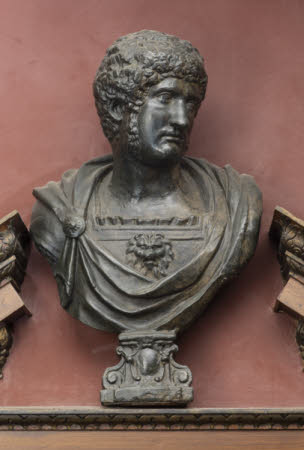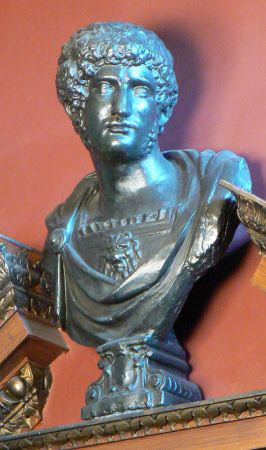Portrait bust of the Roman Emperor Lucius Verus
workshop of Peter Besnier (fl.1643, d.1687-93)
Category
Art / Sculpture
Date
c. 1637 - 1672
Materials
Plaster, Paint
Measurements
780 x 490 x 300 mm
Place of origin
London
Order this imageCollection
Ham House, Surrey
NT 1139665
Summary
Plaster, painted; bust of the Roman emperor Lucius Verus (A.D. 130-69); probably workshop of Peter Besnier; c. 1637-39 or c. 1661-72. Dressed in armour over which is a cloak, his head turned sharply to his left, on a scrolled plinth. The plaster is painted black to simulate bronze, and was probably made in the workshop of Peter Besnier. One of a group of plaster busts installed on the Great Staircase of Ham House in 1671/72.
Full description
A plaster bust depicting the Roman emperor Lucius Verus (A.D. 130-169), with bouffant hair, prominent sideburns and a thin moustache, his head turned sharply to his left. He is dressed in armour with a lion mask embossed on his cuirass, and over this a cloak, fastened with a brooch at the right. The bust is on an integral plinth with a blank shield in the centre, and supported on each side by scrolls. The plaster is painted black to simulate bronze. The bust is a type that is very close to portraits of the emperor Hadrian when young, such as a marble bust in the Museo Nacional del Prado in Madrid, that was in the collection of King Philip II of Spain in the sixteenth century, or a head discovered in the 1950s in the Villa Adriana in Tivoli (Thorsten Opper, Hadrian. Empire and Conflict, exh. cat., British Museum, London 2008, pp. 58-60, figs. 40 and 44). But the identification is not secure and the type is instead more often thought to represent Lucius Verus who, with his adoptive brother Marcus Aurelius, jointly ruled as emperors of Rome from 161 until Lucius Verus’s death in 169, after which Marcus Aurelius continued to rule alone. Born in A.D. 130, Lucius Verus was after the death of his father in 138 adopted by the future emperor Antoninus Pius. He spent much of the eight years of his rule engaged in campaigns against the Parthians in the eastern parts of the Roman empire, and was criticised by contemporaries for his debaucheries. The standard Roman portrait representation of Lucius Verus, as seen for example in busts at Farnborough Hall (NT 830320) and at Ickworth (NT 852235), shows the emperor with the bouffant hair seen in the Ham House bust, but with a full beard and a more severe expression. The Ham House bust on the other hand, which has a distinctively poetic quality, seems to show its subject at a younger age, perhaps about the time that he became joint ruler of Rome. Most of the versions that survive today were in fact modern productions made in Renaissance Italy, notably a number of bronze casts now generally attributed to the Italian sculptor Ludovico Lombardo (c. 1509-1575). The son of the Venetian sculptor Antonio Lombardo, Ludovico worked for much of his career alongside his two brothers in Recanati, but also in Rome. He made a number of distinctive and powerful bronze portrait busts of emperors (Antonia Boström, ‘Ludovico Lombardo and the Taste for the all’Antica Bust in Mid-Sixteenth-Century Florence and Rome,’ in ed. Peta Motture, Large Bronzes in the Renaissance, CASVA, Symposium Papers XLI, National Gallery of Art, Washington 2003, pp. 155-179). The prime version of Ludovico Lombardo’s portrait of Lucius Verus is considered to be the bronze bust in the Bayerisches Nationalmuseum, Munich (Hans Weihrauch, Bayerisches Nationalmuseum München. Die Bildwerke in Bronze und anderen Metallen, Munich 1956, no. 102); compared to the Ham House bust, it has a much smaller bust section and the subject wears a toga, not armour. A similar cast is in the Metropolitan Museum of Art, New York, whilst another version with the head alone, with silvered eyes and mounted on a later marble bust section, was sold in 2018 in New York (Christie’s, 20 April 2018, lot 26, from the collection of Michael Hall). A fragmentary gesso version of the head is in the Museo Liviano in Padua, one of a large group of models and casts from the sixteenth-century collection of the Paduan lawyer Marco Mantova Benavides (Irene Favaretto and Alessandra Menegazzi, eds., Un Museo di Antichita nella Padova del Cinquecento. La Raccolta di Marco Mantova Benavides all’Universita di Padova, Rome 2013, no. 69). The Lucius Verus is one of a group of plaster busts recorded in the 1677 Ham House inventory as ‘4 heades of plaster’ (Charles Avery, Seventeenth-Century Sculpture at Ham House’ in Christopher Rowell, ed., Ham House. 400 Years of Collecting and Patronage, New Haven/London 2013, pp. 158-77, p. 169). These correspond to the four busts in the broken pedimented overdoors leading off various points of the Great Staircase (NT 1139665; 1139678-80). Charles Avery thought that these our busts were most likely to have been installed on the Great Staircase of Ham House in 1637-39, although it is also possible that they were put in place later, around 1671/73, when another three busts on the Staircase wee set on wooden console brackets made in 1673. The busts were originally painted white, to resemble statuary marble, but were repainted dark in the nineteenth century to give them the appearance of bronze. None of the known bronze versions of this portrait type depict Lucius Verus in armour, as in the Ham House plaster bust, whilst the socle is in the auricular style favoured by the sculptors working for King Charles I. It is tempting to speculate whether the plaster might have been taken from a now lost version once in the Royal Collection, which presumably left it with the Commonwealth sales in the early 1650s. Charles Avery has proposed that virtually all the sculpture at Ham House, including the busts on the staircase and those in lead set along the garden walls and on the façade of the house, was made in the workshops of the Besnier family. French in origin, members of the family were appointed as ‘Sculptor in Ordinary’ to, successively, Kings Charles I and II, beginning with Isaac Besnier, who was employed to look after the ‘Moulds, Statues and Modells’ in the royal collections. Isaac probably arrived in London around 1625, perhaps in the retinue of Charles I’s bride Henrietta Maria, and may have left by 1643, when his responsibilities for the sculptures in the royal collections were transferred to his younger brother Peter Besnier (fl. 1643, died 1687/88), to whom is attributed the magnificent bronze bust of Catherine Bruce at Ham House (NT 1139887) as well as the plaster figures of Mars and Minerva in the Great Hall (NT 1139652.1 & 2). After the Restoration Peter Besnier petitioned the new king for restoration of his post and continued to work as a sculptor. His son Thomas (c. 1663-1693) was much praised by George Vertue, whilst another family member, John Besnier, was recorded in 1681 making lead statues for the Duke of Ormonde. Given the close relations between successive monarchs and the owners of Ham, the hypothesis that the Besnier, in the service of the Crown, might have made much of the sculpture at Ham House, is quite plausible. As keeper of the royal sculpture collections, Peter Besnier would have enjoyed privileged access to these collections. The plinth on which the Lucius Verus is placed has similar late Mannerist auricular decoration to that on the socle of Besnier’s bust of Catherine Bruce. Jeremy Warren January 2022
Provenance
Elizabeth Murray and John Maitland, 1st Duke and Duchess of Lauderdale; installed on the Great Staircase of Ham House in 1637-39 or 1671-72; thence by descent, until acquired in 1948 by HM Government when Sir Lyonel, 4th Bt (1854 – 1952) and Sir Cecil Tollemache, 5th Bt (1886 – 1969) presented Ham House to the National Trust. Entrusted to the care of the Victoria & Albert Museum until 1990, when returned to the care of the National Trust, to which ownership was transferred in 2002.
Makers and roles
workshop of Peter Besnier (fl.1643, d.1687-93), sculptor
References
Avery 2013: Charles Avery, ‘Seventeenth-century Sculpture at Ham House’ in Christopher Rowell, ed., Ham House. 400 Years of History, New Haven/London 2013, pp. 158-77., p. 169.

